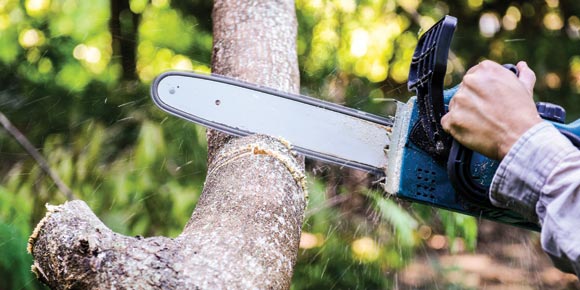by Paul Bianchina
Keeping things safely pruned back is a fact of life for all homeowners. Whether it’s pruning bushes to help maintain a fire-free zone around your house or trimming trees to keep your roof safe from moss and winter storms, you need to have the right tools to do the job quickly and safely.
Outdoor cutting tools can take one of four general forms: gas-powered, electric, battery-operated and — though we hate to even consider them — manual. What you select depends on how much cutting you have to do, where you’ll be cutting, and your budget.
Gas-powered: If you have a lot of cutting to do, especially heavy-duty work such as felling trees or cutting up large branches, or if you’ll be cutting in areas where power is not available, your best bet is a gasoline-powered chainsaw. A 12-inch model — which refers to the length of the bar — is adequate for most pruning tasks, while a 14- to 16-inch bar is a little heavier but more versatile for larger, more heavy-duty cutting.
In addition to chainsaws, several manufacturers also offer hedge trimmers, string and blade trimmers, blowers and other gas-powered equipment for heavy-duty cutting and cleanup work.
Electric-powered: There are several electric chainsaws on the market that will work fine for most pruning and limbing jobs around the house. An electric chainsaw works essentially like a gas-powered one, with the added convenience of not having to worry about noise or gasoline, but the added inconvenience of having to deal with an extension cord.
Some electric chainsaws are available with extension poles. The pole can telescope to different lengths, and is great for small pruning and limbing work in trees and other hard to reach places. For more versatility, look for a saw that is easily detachable from the pole, giving you both a hand-held and a pole-mounted electric chainsaw in the same tool.
Also in the electric category is an interesting new tool from Black & Decker called the Alligator Lopper, which is great for storm cleanup and general pruning and small limbing work. It combines a pair of heavy jaws — capable of gripping anything from small twigs to branches up to four inches in diameter -- with a small chainsaw. Just close the jaws around what you want to cut and then trigger the chainsaw to do the work.
Besides chainsaws, you will also find electric hedge trimmers, string trimmers and blowers to complete your arsenal of pruning and trimming tools.
With any electric-powered tools, it is very important that you follow the manufacturer’s instructions for the proper gauge and length of extension cord to use, and never use a nongrounded extension cord with a tool that requires grounded power — something you can readily recognize by a three-prong plug.
Battery-powered: Everything is a trade-off and with a battery-powered chainsaw, string trimmer or other tool, you have the advantages of quiet, convenient power with no gasoline or extension cords, but at the cost of power and run time.
A battery-powered saw will work fine for small pruning and limbing tasks. You can find battery-powered chainsaws on extension poles for higher pruning work.
Manual tools: Most of us have a tendency to look for power tools to get some extra help with all those cutting and pruning jobs, but don’t overlook the basic muscle-powered tools either. Non-powered tools offer the advantages of convenience, portability, low maintenance and low cost, and you can use them just about anywhere. They are especially handy for working on a roof or on a ladder, where powered tools might be awkward or dangerous.
There are dozens of manual cutting tools available for all sorts of tasks but, for most homeowners, a couple of basic tools will handle just about all your backyard cutting tasks.
Pruning shears are small, relatively light cutters that resemble a pair of scissors. They have two curved cutting jaws, and work well for small pruning jobs. Look for ones that fit comfortably in your hand, and that have a spring to return the jaws to the open position after a cut.
Lopping shears are a larger version of pruning shears. Their two curved jaws are a little longer and heavier duty than those on pruning shears, and they have much longer handles to provide the extra leverage needed for larger pruning and small limbing tasks. Lopping shears are available with both wooden and metal handles in different lengths and weights, so look for one that’s comfortable and convenient to use.
Finally, you might want to consider a pruning saw. Pruning saws have a single curved or straight blade with long coarse teeth and are designed for cutting through tree limbs. They are available in sizes ranging from a small folding model that fits in your pocket to ones mounted on long telescoping metal or fibreglass poles for cutting that high stuff. Look for one that is comfortable and large enough to handle your particular cutting tasks.
— Inman News



